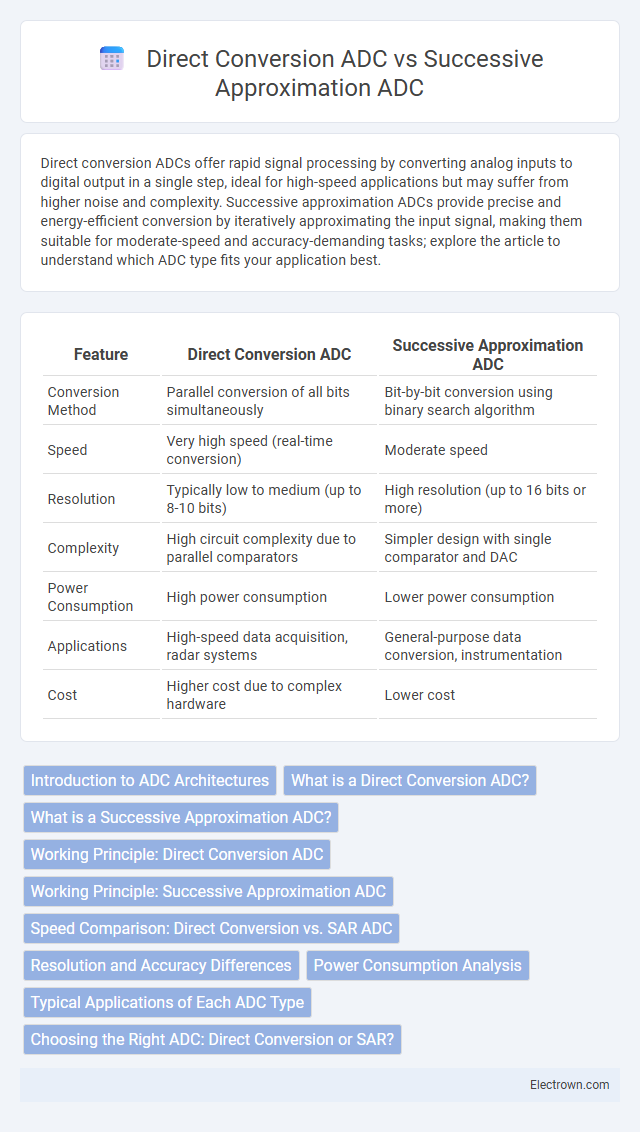Direct conversion ADCs offer rapid signal processing by converting analog inputs to digital output in a single step, ideal for high-speed applications but may suffer from higher noise and complexity. Successive approximation ADCs provide precise and energy-efficient conversion by iteratively approximating the input signal, making them suitable for moderate-speed and accuracy-demanding tasks; explore the article to understand which ADC type fits your application best.
Table of Comparison
| Feature | Direct Conversion ADC | Successive Approximation ADC |
|---|---|---|
| Conversion Method | Parallel conversion of all bits simultaneously | Bit-by-bit conversion using binary search algorithm |
| Speed | Very high speed (real-time conversion) | Moderate speed |
| Resolution | Typically low to medium (up to 8-10 bits) | High resolution (up to 16 bits or more) |
| Complexity | High circuit complexity due to parallel comparators | Simpler design with single comparator and DAC |
| Power Consumption | High power consumption | Lower power consumption |
| Applications | High-speed data acquisition, radar systems | General-purpose data conversion, instrumentation |
| Cost | Higher cost due to complex hardware | Lower cost |
Introduction to ADC Architectures
Direct conversion ADCs convert analog signals to digital in a single step, offering ultra-fast sampling rates ideal for high-frequency applications. Successive approximation ADCs employ a binary search algorithm to progressively approximate the input voltage, balancing speed and accuracy for general-purpose use. Your choice between these ADC architectures depends on the required resolution, speed, and power consumption for your application.
What is a Direct Conversion ADC?
A Direct Conversion ADC, also known as flash ADC, converts an analog signal to a digital output in a single step using multiple comparators for simultaneous threshold detection, enabling extremely high-speed conversion ideal for applications requiring rapid sampling rates. Unlike Successive Approximation ADCs, which use a binary search algorithm over multiple clock cycles to approximate the input voltage, Direct Conversion ADCs offer lower latency but at the cost of increased power consumption and component complexity. The architecture of Direct Conversion ADCs makes them suitable for high-frequency signal processing in radar systems, digital oscilloscopes, and communication devices.
What is a Successive Approximation ADC?
A Successive Approximation ADC converts an analog signal to a digital output by approximating the input voltage through a binary search algorithm using a Digital-to-Analog Converter (DAC) and a comparator. It operates bit-by-bit, refining the result each step to provide a precise and stable conversion ideal for moderate-speed, medium-resolution applications. You benefit from its balanced trade-off between speed, power consumption, and accuracy in systems requiring reliable analog-to-digital conversion.
Working Principle: Direct Conversion ADC
Direct conversion ADC operates by simultaneously sampling the input signal across multiple levels using parallel comparators, enabling immediate digital output generation without intermediate steps. This intrinsic flash architecture employs a resistor ladder to create reference voltages across comparators, which rapidly identify the analog input's quantization level. High-speed performance is achieved due to the parallel processing nature, making Direct conversion ADC ideal for applications demanding ultra-fast digitization.
Working Principle: Successive Approximation ADC
The Successive Approximation ADC operates by employing a binary search algorithm to convert the analog input signal into a digital output, using a digital-to-analog converter (DAC) and a comparator. It starts by setting the most significant bit and progressively adjusts each bit based on comparator feedback, refining the output until it matches the input voltage. This step-by-step comparison process allows for accurate and efficient conversion with moderate speed and resolution.
Speed Comparison: Direct Conversion vs. SAR ADC
Direct conversion ADCs offer significantly higher speed due to their ability to convert analog signals to digital in a single step, making them ideal for high-frequency applications like radar and communication systems. Successive Approximation Register (SAR) ADCs provide moderate speed by iteratively approximating the input voltage, balancing conversion time and power efficiency for applications such as data acquisition and instrumentation. Your choice depends on whether you prioritize ultra-fast conversion or a more power-efficient, moderately fast solution.
Resolution and Accuracy Differences
Direct conversion ADCs offer high resolution with fast conversion speeds but may suffer from lower accuracy due to noise and distortion in the analog front-end. Successive approximation ADCs provide excellent accuracy and stable resolution by using a binary search algorithm, ensuring precise step-by-step voltage comparisons. When your application demands precise digital representation with consistent accuracy, successive approximation ADCs typically outperform direct conversion ADCs despite slightly slower conversion times.
Power Consumption Analysis
Direct conversion ADCs typically consume higher power due to continuous-time operation and complex analog front-end circuitry. Successive approximation ADCs offer lower power consumption by using a sample-and-hold stage and binary search algorithm, optimizing energy efficiency in moderate to high-resolution applications. Power consumption differences are critical in battery-powered and portable devices where SAR ADCs are often preferred for their energy-efficient design.
Typical Applications of Each ADC Type
Direct conversion ADCs excel in high-speed applications such as radar systems, wireless communication receivers, and real-time signal processing where rapid data acquisition is critical. Successive approximation ADCs are commonly used in industrial automation, medical instrumentation, and digital multimeters due to their balance of accuracy, moderate speed, and power efficiency. Your choice depends on whether you prioritize speed and real-time data over precision and power consumption.
Choosing the Right ADC: Direct Conversion or SAR?
Choosing the right ADC depends on your application's speed and accuracy requirements; Direct Conversion ADCs offer high-speed sampling ideal for applications like software-defined radios, while Successive Approximation Register (SAR) ADCs provide high resolution with moderate speed, suitable for precision measurement tasks. Direct Conversion ADCs convert signals instantly without intermediate steps, reducing latency, whereas SAR ADCs use a binary search algorithm to balance conversion time and power consumption efficiently. Your choice should consider factors such as required signal bandwidth, power budget, and acceptable noise levels to optimize overall system performance.
Direct conversion ADC vs successive approximation ADC Infographic

 electrown.com
electrown.com